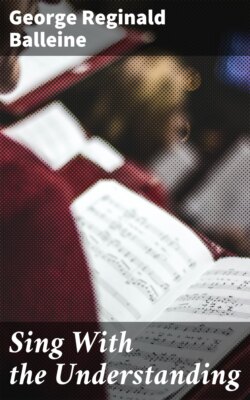Читать книгу Sing With the Understanding - George Reginald Balleine - Страница 3
FOREWORD
ОглавлениеIdeally hymns should contain no obscure words or allusions. If you hand me a hymn-book and invite me to join in the singing, I ought to be able to do so without suddenly having to stop and think, “What on earth do these words mean?” Most good hymns pass this test. “Sun of my soul,” for example, contains not a thought or expression that would puzzle the average scullery-maid. Of the twenty-nine words in its first verse twenty-six are of one syllable. It is surprising how fond the best hymn-writers are of monosyllables, e.g. twenty-eight out of twenty-nine words in the first verse of “Fight the good fight,” twenty-four out of twenty-five words in the first verse of “Stand up and bless the Lord.” But all are not so considerate. Sometimes congregations resemble the
two little birds in a wood
Who sang hymns whenever they could.
What the words were about
They could never make out;
But they thought that it did them some good.
They enjoy hymn-singing, if the tune goes with a good swing. They assume that the words express sentiments that they ought to share. And community-singing of any kind, whether the song be “The Red Flag” or “Abide with me,” psychologically always stirs up a pleasant thrill of emotion. But often there is truth in 10 the sneer of one of Mr. Thompson’s characters in Lancashire Lather: “Look at hymns. You don’t care how daft a hymn is, if you think you are making a worshipful noise.”
This is not entirely our fault. It is partly due to the fact that hymn-writers once could take it for granted that every church-goer had an intimate knowledge of his Bible. The older books are full of allusions that would puzzle most people today. Watts could refer quite casually to “the chariots of Amminadib,” Wesley could exhort his converts to rejoice because “Zerubbabel is near,” and John Newton could assume that his Olney congregation would know what he meant when he cried in that magnificent hymn, “Begone unbelief”:
Each sweet Ebenezer I have in review
Confirms His good pleasure to help me right through.
Modern editors have weeded out many of these recondite expressions; but they still expect “Kedar’s tents,” and “Pisgah’s mountain,” and “the hosts of Midian,” even the “Stem of Jesse’s Rod” to mean something to us.
I fear they are too optimistic. Picture the annoyance of Churchwarden Bullock, who has been singing lustily, “Though like the wanderer the sun gone down” or “Bright the vision that delighted once the sight of Judah’s seer,” if you suddenly whispered, “Who was the wanderer?” or “Who was the seer?” Even the Rev. Lucius Lectern, the newly ordained Deacon fresh from his Theological College, might be puzzled to explain that line in “Crown Him with many crowns,” “Fruit 11 of the Mystic Rose as of that Rose the Stem”; while Mrs. Gubbins, the church-cleaner, almost certainly imagines that the “book which heavenly lore imparts” is the Bible.
The following chapters try to unravel a few of these obscurities. May they help some readers to join St. Paul in his resolve, “I will sing with the spirit and I will sing with the understanding also,” remembering George Herbert’s lines:
The fineness which a Hymn or Psalm affords
Is when the soul unto the lines accords.
